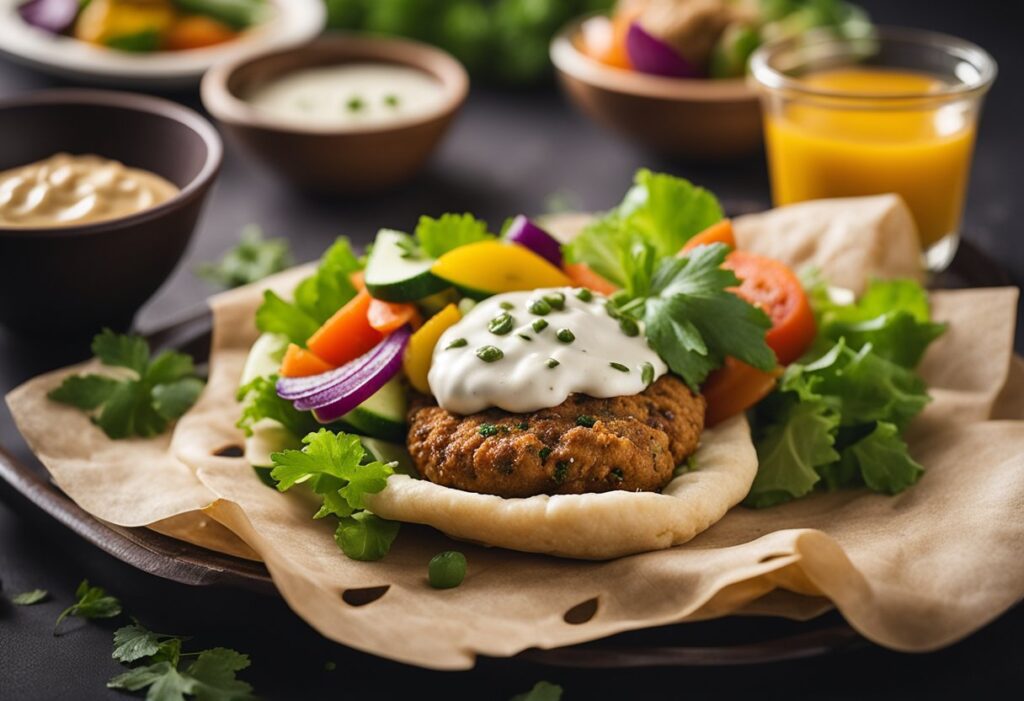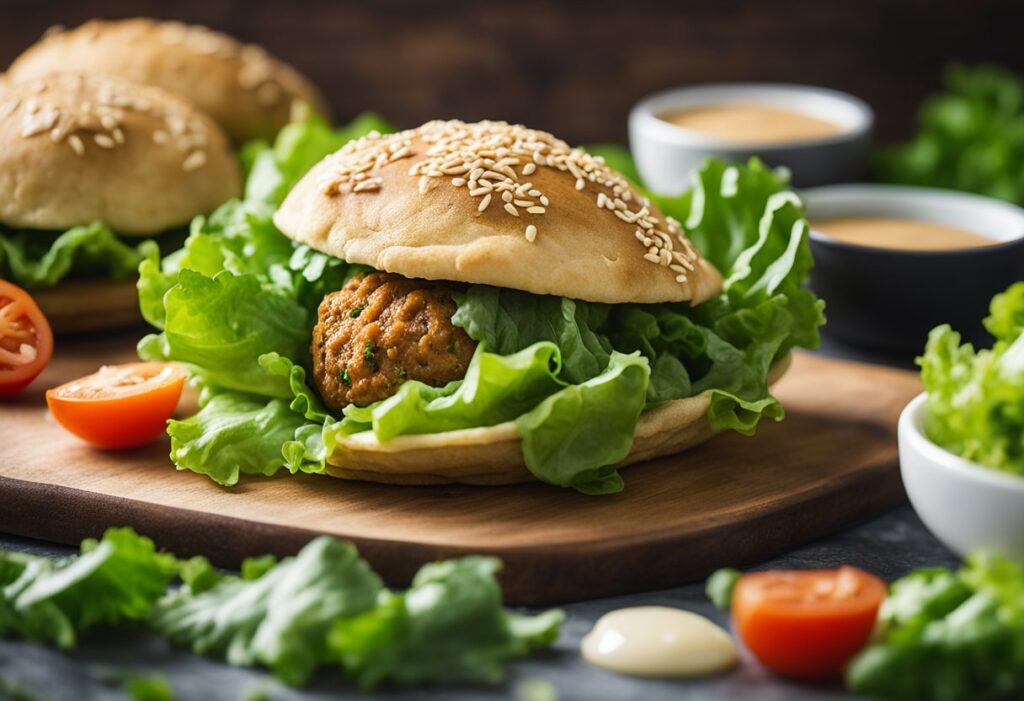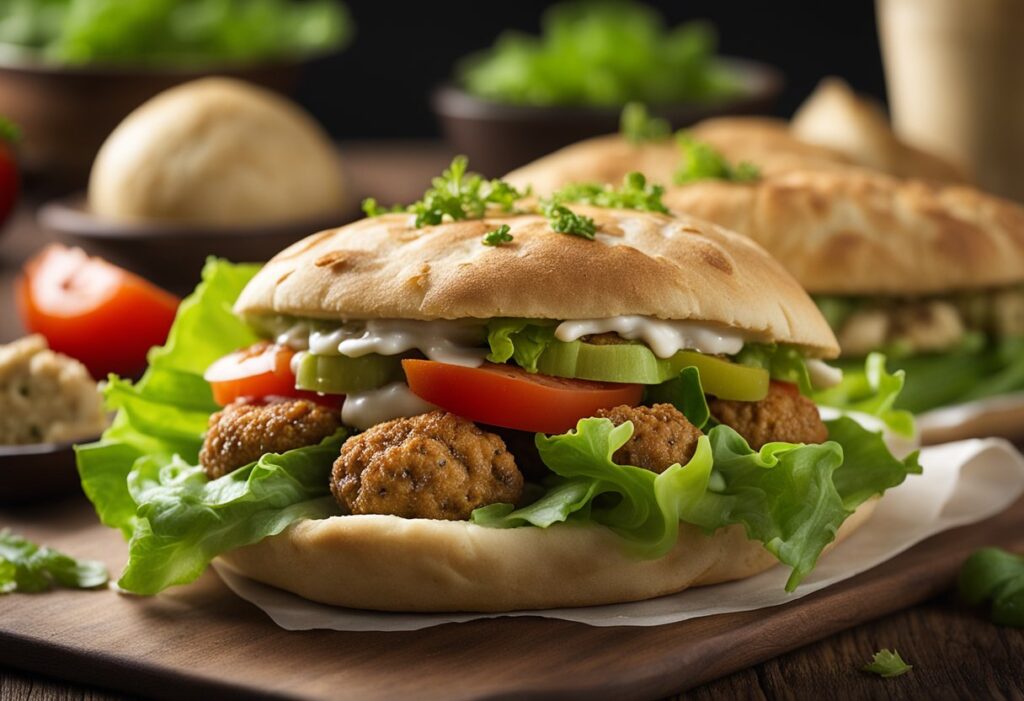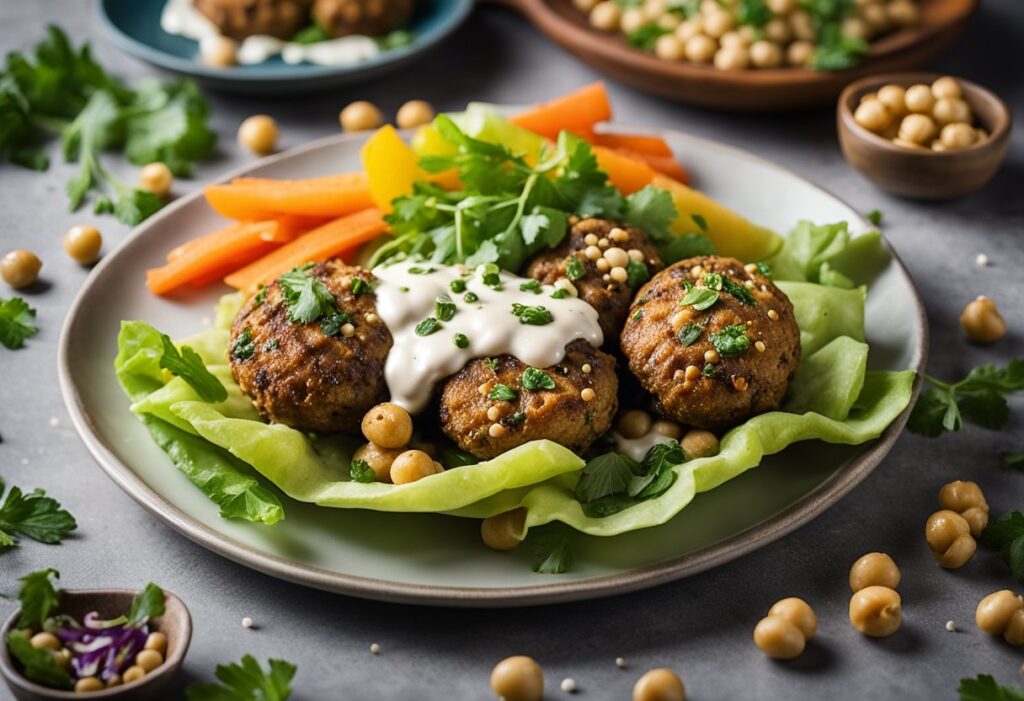Falafel in pita is a popular Middle Eastern dish that has gained popularity around the world. The dish consists of falafel balls, made from ground chickpeas and spices, stuffed inside a pita bread with various toppings and sauces. It is a filling and nutritious meal that can be enjoyed as a snack or a main course.
Table of Contents

Falafel in pita is a staple street food in many Middle Eastern countries, such as Israel, Lebanon, and Egypt. It is also a popular vegetarian and vegan option for those looking for a meat-free meal. The dish is versatile and can be customized with different toppings such as hummus, tahini, pickled vegetables, and hot sauce. It can also be served with a side of fries or a salad for a complete meal.
History of Falafel in Pita

Falafel is a popular Middle Eastern food that has been around for centuries. It is made from ground chickpeas or fava beans mixed with herbs and spices, formed into balls or patties, and then deep-fried. Falafel is often served in pita bread with various toppings and sauces.
The origin of falafel is a matter of debate, with some claiming it originated in Egypt, while others believe it was first made in Palestine. However, most agree that falafel became popular in the Levant region, which includes countries such as Lebanon, Syria, and Israel.
Falafel in pita is a relatively recent innovation. In the past, falafel was often served on its own or with a side of vegetables. However, as the popularity of falafel grew, vendors began serving it in pita bread, which made it easier to eat on the go.
Today, falafel in pita is a staple street food in many Middle Eastern countries and can be found in restaurants and food trucks around the world. It is often served with toppings such as hummus, tahini, pickles, and salad.
Overall, the history of falafel in pita is a testament to the ingenuity of street food vendors and the enduring popularity of this delicious and nutritious food.
Ingredients and Variations

Falafel Balls
Falafel balls are the star of the dish and are made with chickpeas or fava beans, mixed with herbs and spices. The mixture is then formed into small balls and deep-fried until crispy on the outside and tender on the inside. Some variations of falafel balls may include additional ingredients such as onions, garlic, or parsley.
Pita Bread
Pita bread is the perfect vessel for falafel balls, and it is often used to make a sandwich. Pita bread is a round, flatbread that is made from flour, water, and yeast. It can be served warm or cold, and it is usually sliced in half to create a pocket for the falafel balls and toppings.
Toppings and Sauces
The toppings and sauces are what make falafel in pita so delicious and unique. Some common toppings include chopped tomatoes, cucumbers, onions, and lettuce. Sauces can vary depending on the region, but some popular options include tahini sauce, tzatziki sauce, or hummus.
In addition to the traditional toppings and sauces, there are also many variations of falafel in pita that incorporate different flavors and ingredients. For example, some versions may include pickled vegetables, hot sauce, or even French fries.
Overall, the ingredients and variations of falafel in pita offer a wide variety of flavors and textures that are sure to satisfy any craving for a delicious and filling sandwich.
Nutritional Value

Falafel in pita is a popular Middle Eastern dish that is not only delicious but also nutritious. The nutritional value of falafel in pita is dependent on the ingredients used and the preparation method. Generally, falafel in pita is a good source of protein, fiber, and several essential vitamins and minerals.
One of the primary ingredients in falafel is chickpeas, which are a rich source of protein and fiber. Protein is essential for the growth and repair of body tissues, while fiber helps in digestion and promotes satiety. Additionally, falafel is usually made with a variety of herbs and spices such as parsley, coriander, and cumin, which are rich in antioxidants and anti-inflammatory compounds.
Falafel in pita is also a good source of complex carbohydrates, which provide the body with energy. However, it is essential to note that some falafel recipes may contain added fats and sodium, which can increase the calorie content and affect the overall nutritional value of the dish.
To make falafel in pita a healthy and nutritious meal, it is recommended to choose whole-grain pita bread and avoid adding too much sauce or toppings. This will help to keep the calorie and sodium content in check while increasing the fiber and nutrient content of the dish.
Overall, falafel in pita can be a healthy and nutritious meal option when prepared with the right ingredients and consumed in moderation.
Preparation Techniques
Making Falafel
Falafel is a Middle Eastern dish made from ground chickpeas or fava beans mixed with herbs, spices, and other ingredients. There are various ways to make falafel, but the most common method involves soaking the chickpeas overnight and then grinding them along with onions, garlic, parsley, coriander, cumin, and salt. The mixture is then shaped into balls or patties and deep-fried until crispy on the outside and tender on the inside.
To make the falafel healthier, one can also bake or air fry them. Baking falafel requires brushing the falafel balls with oil and then baking them in the oven at 375°F for about 15-20 minutes, flipping halfway through. Air frying falafel requires preheating the air fryer to 375°F, spraying the falafel balls with oil, and then cooking them for about 10-12 minutes, shaking the basket halfway through.
Baking Pita
Pita is a type of flatbread that is commonly used to serve falafel. Baking pita at home is easy and requires only a few ingredients. To make pita bread, one needs flour, yeast, sugar, salt, and warm water. The ingredients are mixed together to form a dough, which is then kneaded until smooth and elastic. The dough is then left to rise for about an hour, after which it is divided into small balls and rolled out into circles. The circles are then baked in the oven at 500°F for about 5-7 minutes until they puff up and turn golden brown.
To make the pita bread more flavorful, one can add herbs, spices, or even cheese to the dough. Additionally, one can also stuff the pita bread with falafel, vegetables, and sauces to make a tasty and filling meal.
Serving and Presentation
When it comes to serving and presenting falafel in pita, there are a few key factors to keep in mind. First and foremost, the pita bread should be fresh and warm. This can be achieved by heating it up in an oven or on a grill, or by wrapping it in a damp towel and microwaving it for a few seconds.
Once the pita is warm, it should be opened up to create a pocket for the falafel. This can be done by gently pulling apart the two sides of the pita, being careful not to tear it. The falafel should then be placed inside the pocket, along with any additional toppings or condiments.
Speaking of toppings and condiments, there are many different options to choose from when it comes to serving falafel in pita. Some popular choices include hummus, tahini sauce, tzatziki, chopped tomatoes, onions, and cucumbers, and pickled vegetables.
To make the presentation of the falafel in pita more appealing, it can be helpful to arrange the toppings in an aesthetically pleasing way. For example, the vegetables can be arranged in a rainbow pattern, or the sauces can be drizzled over the top in a decorative manner.
Overall, serving and presenting falafel in pita is all about creating a delicious and visually appealing meal that is sure to satisfy. By keeping these tips in mind, anyone can create a mouth-watering falafel sandwich that is sure to impress.
Cultural Significance
Middle Eastern Cuisine
Falafel in pita is a popular Middle Eastern dish that is enjoyed by people all over the world. It is a vegetarian dish that is made from ground chickpeas or fava beans, which are mixed with herbs and spices and then fried until crispy. The falafel balls are then stuffed into a warm pita bread, along with fresh vegetables and a variety of sauces.
The origins of falafel are not entirely clear, but it is believed to have originated in Egypt or Palestine. Today, it is a staple food in many Middle Eastern countries, including Israel, Lebanon, and Syria. It is also popular in other parts of the world, including Europe and the United States.
Street Food Culture
Falafel in pita is also an important part of street food culture in the Middle East. It is a quick and easy meal that can be eaten on the go, making it a popular choice for busy people who don’t have time to sit down for a meal. In many cities, there are street vendors who specialize in falafel, and they can be found on almost every corner.
Falafel in pita has become increasingly popular in recent years, as people around the world have become more interested in exploring different cuisines and trying new foods. It is a delicious and healthy option that is perfect for vegetarians and meat-eaters alike, and it is sure to continue to be a favorite for years to come.
Regional Twists on the Classic
Falafel in pita is a classic Middle Eastern dish loved by many around the world. While the traditional recipe calls for chickpeas, herbs, and spices, many regions have put their own twist on the dish to make it unique to their culture.
In Egypt, falafel is made with fava beans instead of chickpeas, giving it a distinct flavor and texture. It is often served with a side of tahini sauce and pickled vegetables.
In Israel, falafel is typically served with hummus and Israeli salad, which consists of diced tomatoes, cucumbers, and onions. Some variations also include pickled cabbage or beets.
In Lebanon, falafel is often served with a variety of mezze dishes, such as tabbouleh, baba ghanoush, and fattoush salad. It is also common to serve falafel with a side of garlic sauce.
In Syria, falafel is sometimes stuffed into a wrap with pickled turnips and a variety of fresh vegetables, such as lettuce, tomatoes, and cucumbers. It is also common to serve falafel with a side of yogurt sauce.
No matter where you go, you are sure to find a unique twist on the classic falafel in pita dish.
Pairings and Accompaniments
Falafel in Pita is a delicious and satisfying meal on its own, but it can be even better when paired with certain foods and accompaniments. Here are a few suggestions for enhancing your falafel experience:
1. Hummus
Hummus is a classic dip made from chickpeas, tahini, lemon juice, and garlic. It pairs perfectly with falafel, adding a creamy and tangy flavor to the dish. Spread a generous amount of hummus on the inside of your pita before adding the falafel balls.
2. Tzatziki
Tzatziki is a Greek yogurt dip made with cucumbers, garlic, and dill. It’s a refreshing and cooling accompaniment that complements the spiciness of the falafel. Add a dollop of tzatziki on top of the falafel balls inside the pita.
3. Tabouli
Tabouli is a Middle Eastern salad made with parsley, tomatoes, onions, and bulgur wheat. It’s a fresh and healthy side dish that adds texture and crunch to the falafel. Serve a small portion of tabouli on the side of your falafel pita.
4. Pickled Vegetables
Pickled vegetables, such as cucumbers, carrots, and turnips, are a tangy and flavorful addition to falafel. They provide a nice contrast to the spiciness of the falafel and add a satisfying crunch. Add a few slices of pickled vegetables to your falafel pita.
5. Hot Sauce
For those who like a little extra heat, hot sauce is a great addition to falafel. Drizzle some hot sauce on top of the falafel balls inside the pita or serve it on the side for dipping.
By pairing falafel with these accompaniments, you can create a delicious and well-rounded meal that is sure to satisfy.
Home Cooking vs. Restaurant Style
When it comes to falafel in pita, there are two main ways to enjoy it: at a restaurant or by making it at home. Each option has its own advantages and disadvantages, and it ultimately comes down to personal preference.
Restaurant Style
For many people, going to a restaurant is the best way to enjoy falafel in pita. Restaurants often have experienced chefs who know how to make the perfect falafel, and they have access to high-quality ingredients that may be difficult to find at home. Additionally, going to a restaurant can be a fun and social experience, especially if you go with friends or family.
However, there are also some downsides to restaurant-style falafel in pita. For one, it can be expensive, especially if you go to a high-end restaurant. Additionally, you may not be able to customize your falafel to your liking, and you may have to wait a while for your food to be prepared.
Home Cooking
Making falafel in pita at home is another popular option. It allows you to have complete control over the ingredients and customize your falafel to your liking. Additionally, it can be a fun and rewarding experience to make your own falafel from scratch.
However, there are also some downsides to making falafel in pita at home. It can be time-consuming and requires some skill in the kitchen. Additionally, it can be difficult to find high-quality ingredients, especially if you live in a rural area.
Overall, whether you prefer restaurant-style falafel in pita or making it at home, both options have their own unique advantages and disadvantages. It ultimately comes down to personal preference and what you’re in the mood for.
Storage and Reheating Tips
Falafel in pita is a delicious and convenient meal that can be enjoyed any time of day. However, it is important to properly store and reheat your falafel to ensure it stays fresh and tasty.
When storing leftover falafel, it is best to keep it in an airtight container in the refrigerator. This will help prevent the falafel from drying out and keep it fresh for up to three days.
To reheat falafel, preheat your oven to 350°F. Place the falafel on a baking sheet and heat for 5-7 minutes, or until heated through. Alternatively, you can reheat the falafel in the microwave for 30-45 seconds, or until heated through.
When reheating falafel, it is important to avoid overcooking it, as this can cause it to become dry and tough. By following these simple storage and reheating tips, you can enjoy delicious falafel in pita anytime, anywhere.
Health Considerations
When it comes to dietary considerations, falafel in pita can be a healthy option for many people. Falafel is made from chickpeas, which are a good source of protein, fiber, and other essential nutrients. The pita bread used to wrap the falafel is typically whole grain, which provides additional fiber and nutrients.
However, there are some things to keep in mind when it comes to the healthfulness of falafel in pita. One potential issue is the amount of sodium in the dish. Falafel is often seasoned with salt, and the tahini sauce that is commonly served with it can also be high in sodium. To mitigate this, diners can ask for less salt to be used in the falafel and can opt for a reduced-sodium sauce or skip the sauce altogether.
Another factor to consider is the calorie content of falafel in pita. While falafel itself is relatively low in calories, the pita bread and any additional toppings or sauces can add up quickly. To keep the calorie count in check, diners can opt for a smaller pita or skip the bread altogether and enjoy the falafel on a bed of greens instead.
Overall, falafel in pita can be a healthy and satisfying meal option for those who are mindful of portion sizes and ingredient choices.

